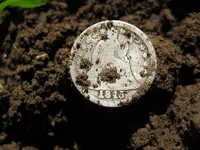mikeofaustin
Bronze Member
- #1
Thread Owner
What would be your experienced best guess on how deep a coin would be in just your typical persons front yard, not a new home where the builder brings in dirt, etc., but in land that's been the same height for forever. Now, a typical yard, consisting of the average family 'traffic'. How 'deep' do you think a coin that was dropped 150 years ago, be in the ground by now.
I was in around a new (~5 years?) volleyball area yesterday and nothing was deeper than 2 inches... including that dang pull tab. I was actually surprised things were even that deep. ...and nope, nothing worth noting was found.
I was actually surprised things were even that deep. ...and nope, nothing worth noting was found.
I was in around a new (~5 years?) volleyball area yesterday and nothing was deeper than 2 inches... including that dang pull tab.
 I was actually surprised things were even that deep. ...and nope, nothing worth noting was found.
I was actually surprised things were even that deep. ...and nope, nothing worth noting was found.




 If we knew where they were, would we need metal detectors, fancy depth finders, or pinpointers?
If we knew where they were, would we need metal detectors, fancy depth finders, or pinpointers? 